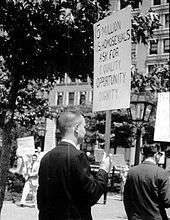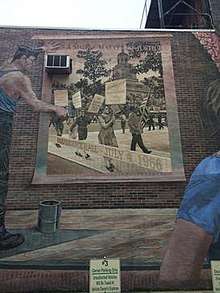Annual Reminder
The Annual Reminders were a series of early pickets organized by LGBTQ organizations, held yearly from 1965 through 1969. The Reminder took place each July 4 at Independence Hall in Philadelphia and were among the earliest LGBT demonstrations in the United States. The events were designed to inform and remind the American people that LGBT people did not enjoy basic civil rights protections.
The Reminders were held each year from 1965 through 1969, with the final picket taking place shortly after the June 28 Stonewall riots, considered the flashpoint of the modern gay liberation movement. Reminder organizers decided to discontinue the July 4 pickets at this point, and shifted their focus to organizing the Christopher Street Liberation Day demonstration held June 28, 1970, to commemorate the anniversary of the riot. This became the first Gay Pride Parade.
Origin

Activist Craig Rodwell conceived of the event following a picket at the White House on April 17, 1965, by members of the New York City and Washington, D.C., chapters of the Mattachine Society, Philadelphia's Janus Society and the New York chapter of the Daughters of Bilitis. The groups operated under the collective name East Coast Homophile Organizations (ECHO).[1] The name of the event was selected to remind the American people that a substantial number of American citizens were denied the rights of "life, liberty, and the pursuit of happiness" enumerated in the United States Declaration of Independence.[2] Enthused by Rodwell's idea, ECHO put together the first Reminder picket in just over two months. Thirty-nine people attended the first picket, including veteran activists Frank Kameny, Barbara Gittings and Kay Tobin.[3] Kameny insisted on a strict dress code for participants, including jackets and ties for the men and dresses for the women. Kameny's goal was to represent homosexuals as "presentable and 'employable'".[4] Picketers carried signs with such slogans as "HOMOSEXUAL BILL OF RIGHTS" and "15 MILLION HOMOSEXUAL AMERICANS ASK FOR EQUALITY, OPPORTUNITY, DIGNITY". The picket ran from 3:30 until 5:00 PM.[3] Press coverage was sparse, although Confidential magazine ran a large feature about the Reminder and other homophile pickets in its October 1965 issue under the headline "Homos On The March".[5]
Final Reminder
The Annual Reminder continued through July 4, 1969. This final Annual Reminder took place less than a week after the June 28 Stonewall riots, in which the patrons of the Stonewall Inn, a gay bar in Greenwich Village, fought against police who raided the bar.[6] Rodwell received several telephone calls threatening him and the other New York participants, but he was able to arrange for police protection for the chartered bus all the way to Philadelphia.[7] About 45 people participated, including the deputy mayor of Philadelphia and his wife.[8] The dress code was still in effect at the Reminder, but two women from the New York contingent broke from the single-file picket line and held hands.[9] When Kameny tried to break them apart, Rodwell furiously denounced him to onlooking members of the press.[10] Similarly to Stonewall, most of Philadelphia's major newspapers did not cover the Annual Reminder. Only the Philadelphia Tribune, The Distant Drummer, and the Temple Free Press covered the event.
Following the 1969 Annual Reminder, there was a sense, particularly among the younger and more radical participants, that the time for silent picketing had passed. As Frank Kameny put it, "[P]icketing as such had become questionable. Dissent and dissatisfaction had begun to take new and more emphatic forms in society."[11] At the November 1–2, 1969 meeting of the Eastern Regional Conference of Homophile Organizations (the successor to ECHO), Ellen Broidy of the NYU Student Homophile League presented Craig Rodwell's proposal for a new commemorative demonstration. The conference passed a resolution drafted by Rodwell, his partner Fred Sargeant,[12] Broidy and Linda Rhodes to move the demonstration from July 4 in Philadelphia to the last weekend in June in New York City, as well as proposing to "other organizations throughout the country... suggest(ing) that they hold parallel demonstrations on that day" to commemorate the Stonewall riot. The newly located event in New York City became known as Christopher Street Liberation Day.[13][14][15][16][17]
Commemoration

The Annual Reminders were commemorated in 2005 by the placement of a Pennsylvania state historical marker by the Pennsylvania Historical and Museum Commission at 6th and Chestnut Streets.[18] On July 4, 2015, the first Annual Reminder was recreated as part of the celebration of the action's 50th anniversary.[19]
In fiction
The 1995 film Stonewall presents a fictionalized Annual Reminder. However, the film sets the Reminder earlier in the summer, predating the June 28 Stonewall riots.
Notes
- Loughery (1998), p. 270.
- Campbell (2007), p. xviii.
- Duberman (1993), p. 113.
- Loughery (1998), p. 271.
- Tobin & Wicker (1972), p. 69.
- Rutledge (1992), pp. 1–2.
- Duberman (1993), p. 209.
- Eisenbach (2006), p. 107.
- Bianco (1999), p. 178.
- Duberman (1993), p. 210.
- Tobin & Wicker (1972), p. 105.
- Sargeant, Fred (1969). "Interview". New Symposium II. Archived from the original on June 14, 2010. Retrieved May 8, 2010 – via David Carter.
- Teal (1971), p. 322.
- Marotta (1981), pp. 164-165.
- Duberman (1993), pp. 226–231.
- Carter (2004), p. 230.
- Eisenbach (2006), p. 108.
- Martinac, Paula. "Annual Reminder Marker". National Trust for Historic Preservation. Archived from the original on August 1, 2011. Retrieved April 3, 2017.CS1 maint: BOT: original-url status unknown (link)
- Philly celebrates LGBT milestone with anniversary ceremony, block party
References
- Bianco, David (1999). Gay Essentials: Facts For Your Queer Brain. Los Angeles: Alyson Books. ISBN 1-55583-508-2.CS1 maint: ref=harv (link)
- Campbell, J. Louis, III (2007). Jack Nichols, Gay Pioneer: 'Have You Heard My Message?'. New York: Harrington Park Press. ISBN 1-56023-653-1.CS1 maint: ref=harv (link)
- Carter, David (2004). Stonewall: The Riots That Sparked The Gay Revolution. New York: St. Martin's Press. ISBN 0-312-20025-0.CS1 maint: ref=harv (link)
- Duberman, Martin (1993). Stonewall. New York: Dutton. ISBN 0-452-27206-8.CS1 maint: ref=harv (link)
- Eisenbach, David (2006). Gay Power: An American Revolution. New York: Carroll & Graf Publishers. ISBN 0-7867-1633-9.CS1 maint: ref=harv (link)
- Loughery, John (1998). The Other Side of Silence: Men's Lives and Gay Identities: A Twentieth-Century History. New York: Henry Holt and Company. ISBN 0-8050-3896-5.CS1 maint: ref=harv (link)
- Marotta, Toby (1981). The Politics of Homosexuality. Boston: Houghton Mifflin. ISBN 0-395-31338-4.CS1 maint: ref=harv (link)
- Noland, Alaina (2016). "Reminder Days". The Encyclopedia of Greater Philadelphia. Camden: Rutgers University.CS1 maint: ref=harv (link)
- Rutledge, Leigh (1992). The Gay Decades. New York: Plume. ISBN 0-452-26810-9.CS1 maint: ref=harv (link)
- Stein, Marc (2004). City of Sisterly and Brotherly Loves: Lesbian and Gay Philadelphia, 1947-1972. Chicago: University of Chicago Press. ISBN 1-59213-130-1.CS1 maint: ref=harv (link)
- Teal, Donn (1971). The Gay Militants. New York: Stein and Day. ISBN 0-8128-1373-1.CS1 maint: ref=harv (link)
- Tobin, Kay & Wicker, Randy (1972). The Gay Crusaders. New York: Paperback Library. ISBN 0-446-66691-2.CS1 maint: ref=harv (link)
- "The 5th Annual Reminder Day Protests at Independence Hall". wordpress.com. Retrieved 13 March 2018.